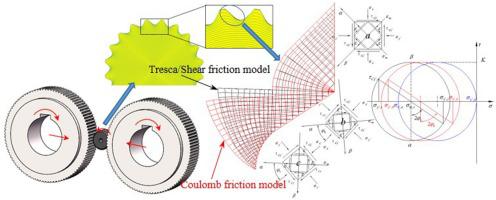Journal of Materials Processing Technology ( IF 6.7 ) Pub Date : 2021-01-23 , DOI: 10.1016/j.jmatprotec.2021.117059 Da-Wei Zhang , Fang-Fang Xu , Zai-Chi Yu , Kun-Yin Lu , Ze-Bang Zheng , Sheng-Dun Zhao

|
The plastic deformation during external spline rolling process (ESRP) is concentrated in the superficial area of workpiece. The numerical simulation for full 3D spline rolling process is time-consuming, and experimental measure during the rolling process is also difficult, and there is no clear physical meaning between results and parameters. The analytical models for ESRP have been modeled by slip-line field method (SLFM) with Coulomb friction model (CFM), Tresca friction model (TFM) and Coulomb-Tresca friction model (CTFM), respectively. The SLFM models can represent the influence of geometrical and frictional parameters on the ESRP. The slip line fields of ESRP under different friction models all contain 3 slip-line sub-regions for workpiece only with circular dedendum and all contain 5 slip-line sub-regions for workpiece with involute flank. Compared with experimental and numerical results, the error of SLFM (slip-line field method) result such as undeformed zone of the workpiece is less than 10 % between SLFM results and the experimental and FEM results. The error between SLFM and FEM for normal stress on contact surface is less than 10 %. The geometrical parameter and friction condition have an important influence on the applicability of CTFM. CTFM only works in the rolling process with small pressure angle (such as 14.5° for gear) and friction condition (0.7<m<0.8) between lubrication and dry friction; and for other cases, the CTFM degenerates into a TFM. The developed SLFM model in this study can provide a basis for studying deformation mechanism, rapidly determining reasonable parameter range, and simplifying finite element model of spline or gear rolling process. The results in this study also provided reference for selection of friction model in finite element analyses of complex profile rolling.
中文翻译:

库仑,特雷斯卡和库仑-特雷斯卡摩擦模型用于外花键滚动过程的解析分析
外部花键滚压过程(ESRP)中的塑性变形集中在工件的表层区域。全3D花键滚动过程的数值模拟非常耗时,并且在滚动过程中也很难进行实验测量,结果和参数之间没有明确的物理含义。通过滑移线场法(SLFM),库仑摩擦模型(CFM),特雷斯卡摩擦模型(TFM)和库仑-特雷斯卡摩擦模型(CTFM)分别对ESRP的分析模型进行了建模。SLFM模型可以表示几何参数和摩擦参数对ESRP的影响。在不同摩擦模型下,ESRP的滑移线场都包含3个仅用于齿根为圆形的工件的滑移线子区域,并且都包含5个具有渐开线后齿的工件的滑移线子区域。与实验和数值结果相比,SLFM(滑移线场法)结果的误差(例如工件的未变形区域)在SLFM结果与实验结果和FEM结果之间的误差小于10%。对于接触表面上的法向应力,SLFM和FEM之间的误差小于10%。几何参数和摩擦条件对CTFM的适用性有重要影响。CTFM仅在压力角较小(例如齿轮为14.5°)和摩擦条件(0.7 < 几何参数和摩擦条件对CTFM的适用性有重要影响。CTFM仅在压力角较小(例如齿轮为14.5°)和摩擦条件(0.7 < 几何参数和摩擦条件对CTFM的适用性有重要影响。CTFM仅在压力角较小(例如齿轮为14.5°)和摩擦条件(0.7 <m <0.8)在润滑和干摩擦之间;对于其他情况,CTFM会退化为TFM。本研究建立的SLFM模型可以为研究变形机理,快速确定合理的参数范围,简化花键或齿轮轧制过程的有限元模型提供基础。研究结果为复杂型材轧制有限元分析中摩擦模型的选择提供了参考。











































 京公网安备 11010802027423号
京公网安备 11010802027423号